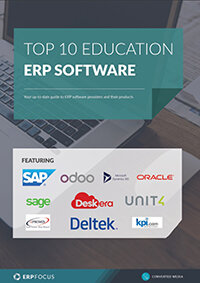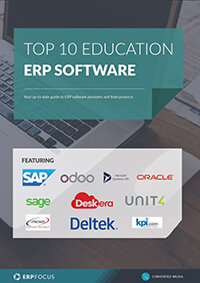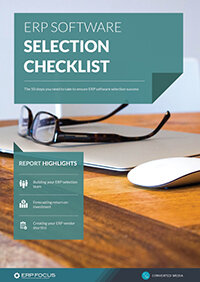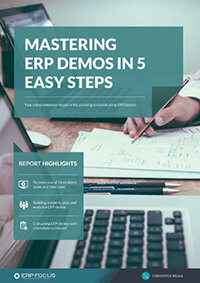Finding your top ERP for higher education
Higher education needs ERP just like other enterprises and developers have come to the rescue. Higher education includes any form beyond the required high school level, including colleges, universities, and vocational programs, whether public or private. All are enterprises with complex requirements and there is an ERP that can help manage your school too.
ERP benefits
We should expect an ERP to improve conditions for the entire organization, including instructors, administrators, students, support staff, and the facilities management of the school.
Instructors and faculty
Instructors and other faculty will benefit from good scheduling of classes around other requirements such as time for grading student’s work, research, and personal needs. Instructors will know the ERP has planned for textbooks and other materials to be available for the students in advance of any class requirements.
Students
Students will know that ERP has used their planned class requirements as a factor in scheduling instructor time in order that they can complete their coursework as planned to the extent possible optimizing the schedules for the school and other students. Students can be confident that any scholarships or grants they earned will be netted against the gross tuition so they only pay the amount due from them and can plan their expenses with accuracy.
Support staff
Support staff will use ERP to plan their work for the best benefit to the students and faculty. For example, the health clinic on campus can see the ages, genders, and other demographics of the expected students in the future and manage to have the right kind of health care available when it will be needed.
Facilities
Facilities can use classroom schedules to arrange janitorial service for clean rooms and even schedule lawn mowing avoiding loud noise outside of classes in session. Major service can be planned to avoid times when students are moving into the dormitory. When needed, entire sections of buildings can be closed to class schedules and the downtime loaded as a factor in the ERP schedule so that preventative maintenance can be completed with little interruption to the class schedule.
Administration
Administrative people will be the primary users of the ERP and will benefit as well. Higher education ERP contains a student information system component that tracks every current and past student with identification details, their class and grade history, and courses required for their programs. Administrative tracking begins when the prospective student inquires at the school and continues through the former student’s alumni years keeping the student a part of the school family and providing for development opportunities. Students, too, use the student information system when they complete their on-line registration before each term. Then, at the end of the term, faculty will enter the grades earned into the same student information system.
Payroll is a component of higher education ERP. Payroll can include normal hourly and salaried rates. Payroll also must allow for contract rates allowed for certain faculty, additional earnings related to publishing and research, and other special cases. Some faculty, such as graduate assistant instructors, might have their pay offset by reduced class enrollment fees. Athletic coaches might have bonus factors in their payroll such as additional money for championships.
Administration people also need financial systems in the ERP for bill paying and management of payables. Revenue can come from student tuition, grants and scholarships for students and faculties, and other grants and revenue related to such as faculty and graduate student research for government and business. There will be financial reports required for tax and government reporting and other compliance requirements.
Higher education ERP has to provide a set of systematic processes for all users and stakeholders that is easy to follow and supports all necessary transactions collecting data to be used by all for decision making.
ERP should help reduce expenses throughout the enterprise. ERP should organize data. ERP will help all users reinforce their relationships with parents and other stakeholders.
Higher education ERP
Elucian has two ERP systems built off of best practices from our community of schools as well as our 50 years of experience, higher education is their only business. Banner is the world’s leading higher education ERP—the solution of choice for over 1,500 institutions in 40 countries. With the industry’s most comprehensive set of features and future-ready technology, Banner strengthens every major workflow in higher education, from student recruiting and retention to talent attraction and management.
Jenzabar is another ERP provider that has served the higher education world for many years. They offer Sonis, designed specifically for smaller higher education and vocational institutions. One which is a flexible cloud-ready platform exclusive to higher education. One includes tools for analytics, e-learning, enrollment, finance, financial aid, fundraising, human resources, retention, and students. Jenzabar says their products are intuitive to use, affordable in cost, and powerful in action.
Orbund provides a higher education system called Einstein. They are a newer provider, founded in 2003. Einstein is cloud-based and empowers smaller institutions with big university services open to integrations and cost-efficient. Orbund includes built-in CRM and LMS for better recruiting and bountiful e-learning. Integrate your favorite applications as needed.
There are open source ERP systems such as AcademiaERP that deserve consideration. This comprehensive suite streamlines the complete student life cycle from inquiry to graduation as well as administrative processes such as inventory, hlibrary, human resources etc. The product is built on cutting-edge Java technology and is robust and scalable. The developer’s association with over 200 educational institutes in India and internationally has helped them incorporate some of the best ideologies and practices into the products, thereby making “Academia ERP” a preferred choice for the education sector.
Some schools use general-purpose ERP systems such as Sage, Epicor, or Oracle. While these are not designed specifically for higher education, they are powerful, feature-filled systems that can all be customized as needed and integrated with many third-party systems that fulfill needs specific to any institutions.
There is no single best ERP for higher education. The ERP that is best for your school is the one that meets all the “must have” requirements and as many as possible of the “nice to have” points that you and your selection team put together. You could find that one of the ERPs above is right for you but there are many more available.
Free white paper

Top 10 Education ERP Software Comparison
Get your free comparison of the top 10 education ERPs

Featured white papers
-

ERP Software Pricing Guide
Get the latest pricing information on over 80 popular ERP systems, and learn how to budget for your ERP project in our free guide
Download -

60-Step ERP Selection Checklist
Get the comprehensive checklist for your ERP selection project
Download -

ERP Demo Guide & Scorecard
Master your ERP demo with 5 easy steps using our free guide (includes demo scorecard)
Download
Related articles
-

The best ERP systems for process manufacturing
Consider these ERP systems when selecting your next process manufacturing ERP
-

CMMC Compliance: What Aerospace and Defense Manufacturers Need to Know
Key insights on CMMC compliance, deadlines, and securing DoD contracts with CMMC 2.0 certificatio...
-

5 ERP pricing definitions you need to understand
Have you mastered the ERP pricing lexicon yet? Getting to grips with these five definitions is a ...

